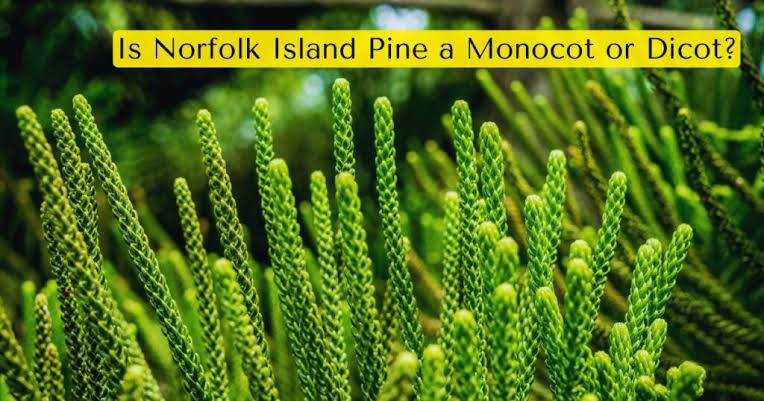If you’ve ever admired the Norfolk Island Pine (Araucaria heterophylla), you might have wondered about its botanical classification. Is it a monocot or a dicot? This is a surprisingly common question among plant enthusiasts, especially those fascinated by the unique characteristics of this tropical evergreen. In this blog post, we’ll explore the answer to this intriguing question and provide a deeper understanding of what makes this plant so special.
What Are Monocots and Dicots?
Before diving into the specifics of the Norfolk Island Pine, let’s start with the basics: monocots and dicots. These two categories are used to classify flowering plants based on the structure of their seeds.
- Monocots: Plants with seeds that contain a single embryonic leaf, or cotyledon. Common examples include grasses, lilies, and palms.
- Dicots: Plants with seeds that contain two embryonic leaves, or cotyledons. Roses, sunflowers, and beans fall into this category.
These classifications apply exclusively to flowering plants, also known as angiosperms.
The Truth About the Norfolk Island Pine
Now that we’ve covered monocots and dicots, here’s the surprising part: the Norfolk Island Pine is neither a monocot nor a dicot. Instead, it belongs to a completely different group of plants called gymnosperms.
1. What Are Gymnosperms?
Gymnosperms are seed-producing plants that do not produce flowers or fruit. Instead, their seeds are exposed and often borne on cones. Common gymnosperms include pines, spruces, and firs.
The Norfolk Island Pine is part of this group, which sets it apart from flowering plants. Its seeds develop on large cones rather than inside fruits or flowers, making the monocot/dicot classification irrelevant.
2. Family and Origin
The Norfolk Island Pine belongs to the family Araucariaceae. It’s native to Norfolk Island, a small territory in the Pacific Ocean near Australia. Although it’s called a “pine,” it’s not a true pine but a relative of other coniferous trees.
Unique Characteristics of the Norfolk Island Pine
The Norfolk Island Pine stands out not only for its botanical classification but also for its striking appearance and adaptability.
1. Symmetrical Growth
One of the most distinctive features of the Norfolk Island Pine is its perfectly symmetrical growth habit. Its horizontal branches grow in whorls around the trunk, creating a tiered, conical shape that resembles a Christmas tree.
2. Evergreen Foliage
The tree’s needle-like leaves are soft to the touch, giving it a delicate, feathery appearance. Unlike many conifers, the Norfolk Island Pine thrives indoors as a houseplant, provided it gets sufficient light and care.
3. Longevity and Size
In its natural habitat, this tree can grow up to 200 feet tall. Indoors, however, it usually stays under 6 feet, making it a manageable and decorative choice for homes and offices.
How to Care for a Norfolk Island Pine
If you’re considering adding a Norfolk Island Pine to your plant collection, proper care is essential to keep it thriving.
1. Light Requirements
The Norfolk Island Pine loves bright, indirect sunlight. Place it near a window where it can receive plenty of light without being exposed to harsh, direct rays.
2. Watering Needs
Keep the soil evenly moist but not waterlogged. Overwatering can lead to root rot, while underwatering can cause the needles to dry out and drop.
3. Temperature and Humidity
As a tropical plant, it prefers warm temperatures and high humidity. Keep it in a room with temperatures between 65°F and 75°F (18°C to 24°C), and consider misting it or using a humidifier if the air is dry.
4. Fertilizing
Feed the plant with a balanced liquid fertilizer during the growing season (spring and summer). Reduce feeding during the dormant months of fall and winter.
What Competitors Miss About the Norfolk Island Pine
While other articles may touch on the Norfolk Island Pine’s care or classification, they often miss crucial details. Here’s how this post stands out:
- Clarification on Gymnosperm Classification: Many sources fail to explain why the monocot/dicot distinction doesn’t apply, leaving readers confused.
- Detailed Characteristics: This post highlights specific features like symmetrical growth and soft foliage that make the plant unique.
- Practical Care Tips: Unlike competitors, this post provides actionable advice for keeping the plant healthy indoors.
Fascinating Facts About the Norfolk Island Pine
Did you know?
- The Norfolk Island Pine was historically used as a ship mast by early explorers due to its tall, straight trunk.
- It’s a popular choice for a tabletop Christmas tree, thanks to its festive appearance.
- Despite its name, it’s not related to true pine trees (genus Pinus).
Conclusion
So, is the Norfolk Island Pine a monocot or a dicot? Neither! This remarkable plant belongs to the gymnosperms, a group of non-flowering plants that predates both monocots and dicots in evolutionary history.
With its symmetrical growth, evergreen beauty, and adaptability to indoor living, the Norfolk Island Pine is a stunning addition to any plant collection. Whether you’re drawn to its unique characteristics or its fascinating history, this plant is sure to bring a touch of elegance to your space.



